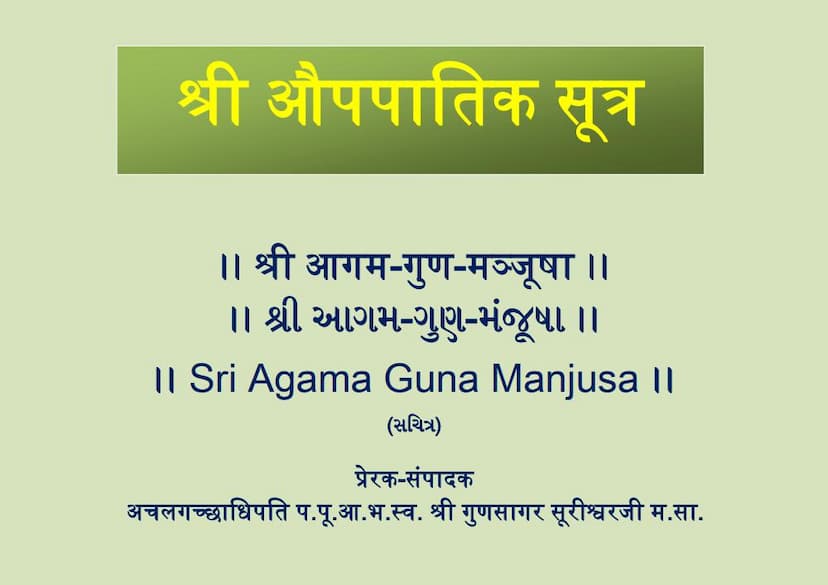Agam 12 Upang 01 Auppatik Sutra Shwetambar Agam Guna Manjusha
Added to library: September 1, 2025

Summary
This document is a Jain text, specifically the Auppatik Sutra, which is an Upanga (secondary scripture) within the Shwetambar Agam canon. The publication is part of the "Agam Guna Manjusha" series, compiled and inspired by Acharya Shri GunSagar Surishwarji. The text includes an introduction to 45 Agamas, followed by a detailed description and commentary on the Auppatik Sutra itself, presented in Gujarati and then in English (transliterated and translated).
Here's a breakdown of the content:
Overall Structure:
- Introduction to 45 Agamas: Pages 2-7 provide a summary of the entire Jain Agam literature, categorizing it into Angas, Upangas, Prakirna Sutras, Cheda Sutras, Mula Sutras, and Culika Sutras, briefly describing the content and approximate number of verses for each.
- Auppatik Sutra Details: Pages 8-34 focus exclusively on the Auppatik Sutra (also known as Upavada, Uvavaiya, or Oavaiya). It provides its Jain Agam classification (Upanga 12), its primary genre (Kathanuyoga/religious discourses), and details about its structure (chapters, sections, verse count, prose/verse format).
- Content of Auppatik Sutra:
- Pages 8-30 delve into the detailed narrative of the Auppatik Sutra. It describes the city of Champa, Lord Mahavira's visit there, the sacred Punnabhadra Chaitya, various trees and flora.
- It recounts the presence of King Konika and his retinue, as well as the arrival of various celestial beings like Asurakumara, Jyautishika, and Vaimanika gods in Lord Mahavira's Samavasarana (assembly).
- The text details the descriptions of these gods, including their lifespans, forms, and insignia.
- It also touches upon Lord Mahavira's disciples, their different types of penance (external and internal), and various spiritual states.
- The latter part of the text details the teachings of Lord Mahavira to the assembled beings, covering various aspects of Jain philosophy, karma, rebirth, vows, and liberation.
- It specifically discusses the teachings related to the layman's path (Upāsaka Dharma) and the monk's path (Anagar Dharma).
- There is a significant section that narrates the story of Ambaḍa Parivrajaka and his disciples, highlighting their practices and eventual path to liberation.
- The text also discusses the characteristics and previous births of various divine beings and important figures in Jain cosmology and history.
- A substantial portion is dedicated to the detailed descriptions of the Samavasarana, the king's procession, and the elaborate arrangements made for Lord Mahavira's sermon.
- The text emphasizes the nature of the soul, karma, and the path to liberation through ethical conduct, penance, and knowledge, as expounded by Lord Mahavira.
- The latter pages (especially 31-34) seem to elaborate on the concept of Siddhas (liberated souls) and their existence in the highest realms of the universe, discussing their physical characteristics (or lack thereof), their spiritual state, and the process of liberation. It also includes verses summarizing these concepts.
Key Themes and Content Areas:
- Cosmology and Geography: Descriptions of cities like Champa, sacred sites, and celestial realms.
- Lord Mahavira: His teachings, his disciples, his sermon in the Samavasarana.
- Deities: Detailed accounts of various classes of celestial beings (Asurakumara, Jyautishika, Vaimanika, etc.), their attributes, and their reverence for Lord Mahavira.
- Penance and Asceticism: Extensive discussion of various forms of penance, both external and internal, undertaken by monks and nuns.
- Jain Philosophy: Concepts like karma, rebirth, liberation (moksha), vows (anuvratas, gunavratas, shikshavratas), soul (jiva), non-soul (ajiva), attachment, aversion, and the path to spiritual purification.
- Ethics and Conduct: Rules and guidelines for both monastic and lay followers.
- Narrative Accounts: Stories and life-sketches of important souls, including King Konika, Ambaḍa Parivrajaka, and various disciples.
- The Nature of Siddhas: Detailed discussion on the characteristics and existence of liberated souls in the highest realms.
- The Agam Canon: The introductory section highlights the structure and importance of the entire body of Jain scriptures.
In essence, the Auppatik Sutra is a foundational Jain text that describes a significant event in Lord Mahavira's life – his Samavasarana sermon in Champa. It uses this event as a framework to expound upon core Jain doctrines, celestial hierarchies, ethical principles, and the ultimate goal of liberation, providing rich detail about the spiritual path and the beings who traverse it. The accompanying publication aims to make this complex scripture accessible by providing context and explanations.